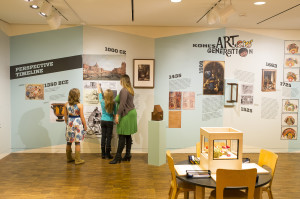For additional resources, see the Kohl’s Art Generation Online Lab & Gallery guide.

1350 BCE
Figures in ancient Egyptian art are flat, shown on one plane. Depth is often suggested by overlapping forms.
300 BCE
Paintings on ancient Greek vases show an early kind of perspective based on observation rather than on mathematical rules, which came later.
1000 CE
Living in Spain around 1000 CE, Alhazen was a great authority on optics. He built on what the ancient Greeks knew of optics, which is the science of light, and invented the first pinhole camera, called a camera obscura. He used a dark room that had a pinhole in the wall at one side of the room. By the 1700s, Alhazen’s original room-sized device had been reduced to a portable box.
The camera obscura uses sunlight to make an image. Read more about the camera obscura in the Technology section.
1435
Two architects living in Florence, Italy, during the early fifteenth century—Leon Battista Alberti (1404–1472) and Filippo Brunelleschi (1377–1446)—are credited with developing a system called linear perspective. The architects used the metaphor of an archer to explain how it works. Just as an archer closes one eye and aims the arrow at a fixed target, so an artist should imagine a straight line from the center of the eye to the composition’s vanishing point, where the angular perspective lines of an object eventually meet on the horizon. (Check out this illustration to see it in action.)
1508
Italian painter Leonardo da Vinci (1452–1519) was the first to define aerial perspective, which explains how light and color help us understand space in an outdoor setting. Light in the atmosphere is variously absorbed and reflected by dust and moisture. There is more dust and moisture closer to the ground, where they reflect and scatter light. This scattering causes colors in the distance to lose their sharpness and look blurry. Blue light is able to penetrate the dust and moisture most easily (it is absorbed the least relative to the other colors in the light spectrum); this makes the sky appear blue and gives distant objects a bluish cast. For centuries, artists have mimicked this effect of nature, using cooler, paler tones (like blue) toward the horizon.
The landscape in Virgin of the Rocks by Leonardo da Vinci is a perfect example of aerial perspective. The rocks closest to the viewer are brown-green, while the rocks farther in the distance are a clear blue. The most distant rocks are somewhat hidden by a white mist.
1525
German painter Albrecht Dürer (1471–1528) invented a framing device to record the world more accurately. It consists of a squared net of black threads stretched over a sturdy wooden frame. An eyepiece, which fixes the artist’s viewpoint, is positioned at a specific distance from the device. The artist looks through the sight and copies the outlines of the object onto a squared drawing surface. The artist draws the image one square at a time.
1663
The Dutch master Samuel Van Hoogstraten (1627–1678) was a pupil of Rembrandt’s, but his perspective peepshows made him famous. Find out more about peepshow boxes on the Technology page.
1725
In the eighteenth and nineteenth centuries, semicircular anamorphic (or distorted) images were popular. Find out more about anamorphic images on the Technology page.
1806
The camera lucida that English chemist W. H. Wollaston (1766–1828) patented in 1806 is a precise aid to perspective drawing. Find out more about the camera lucida on the Technology page.
1910
In the twentieth century, the way artists thought of space changed. “Art consists of inventing not copying,” declared French artist Fernand Léger (1881–1955). Léger broke up his image into many parts, giving us a multifaceted fly’s-eye view of reality. This perspective differed greatly from linear perspective. We are no longer looking at an object from just one viewpoint, but from many points of view all at once.
1953
Modern and contemporary artists often create space that we can’t quite figure out. Dutch artist M. C. Escher (1898–1972) is famous for the curious effects he created by combining various (and often conflicting) vantage points; for instance, looking up and down at the same time. Look at this artwork and notice how the direction of the stairs does not quite make sense.

